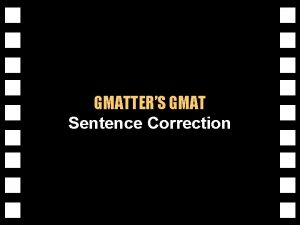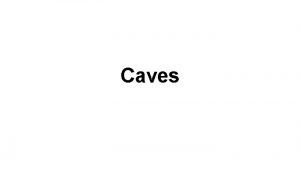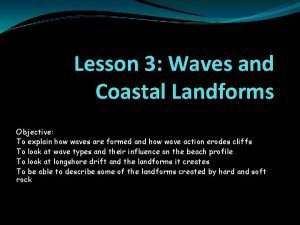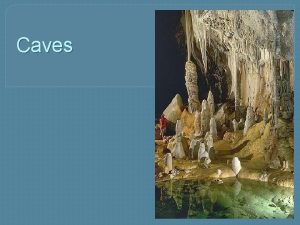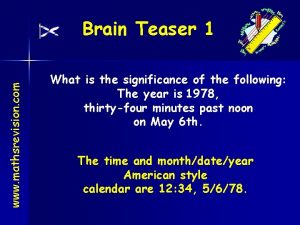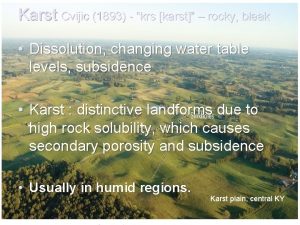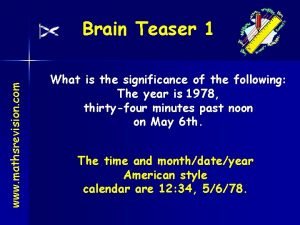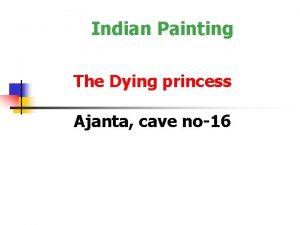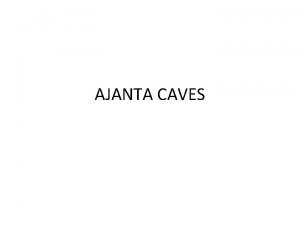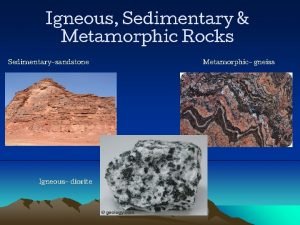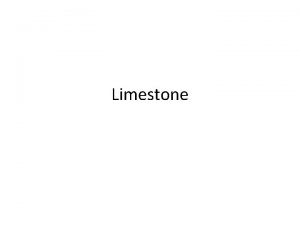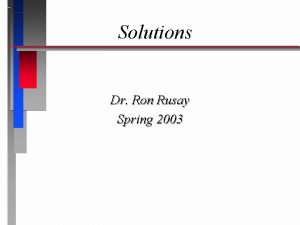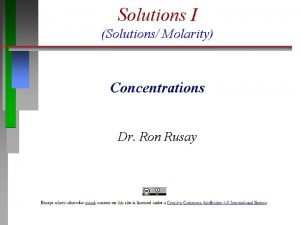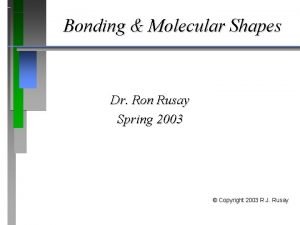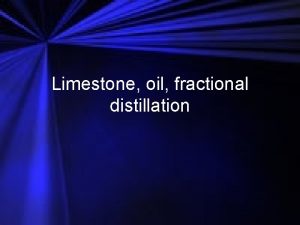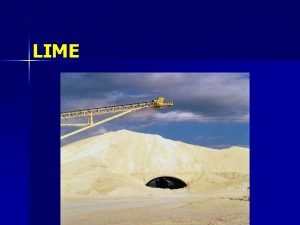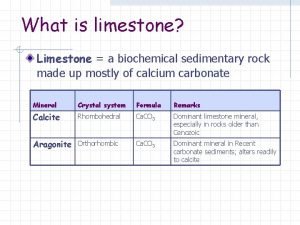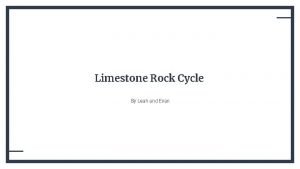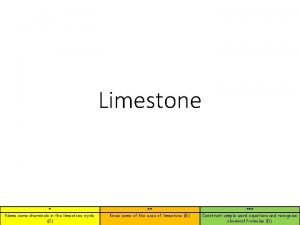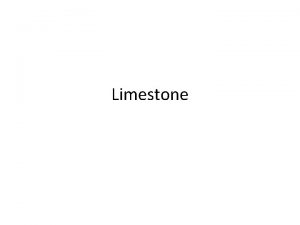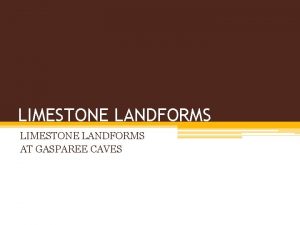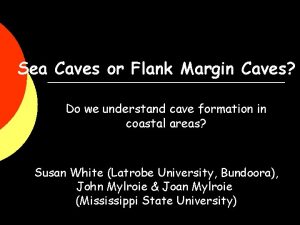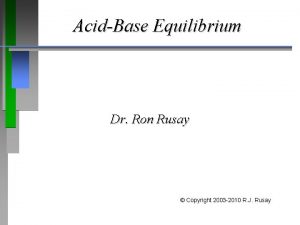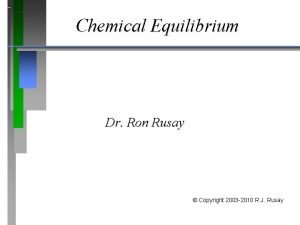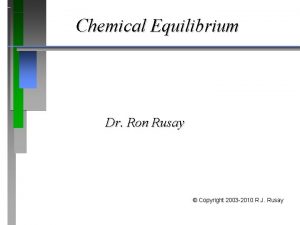Solutions Dr Ron Rusay Spring 2003 Limestone Caves






















- Slides: 22

Solutions Dr. Ron Rusay Spring 2003

Limestone Caves: Solubility of Ca. CO 3


Solutions Substances can mix together to form homogeneous mixtures (solutions). The material present in the larger amount is the solvent and the other(s) is (are) the solute(s). Together they form a solution. The most common solutions are liquids. The solute can be a solid, liquid or gas which is dissolved in a liquid solvent. The most common solvent is water. © Copyright 1995 -2001 R. J. Rusay

DHMO, dihydromonoxide : “The Universal” Solvent http: //www. dhmo. org

Water as a Solvent The oil (nonpolar) and water (polar) mixture don’t mix and are immiscible. If liquids form a homogeneous mixture, they are miscible. Generally, likes dissolve likes, i. e. polar-polar and nonpolar-nonpolar. If polar and nonpolar mix , eg. oil and water:

Salt dissolving in a glass of water


Water dissolving an ionic solid

Concentration and Temperature Relative Solution Concentrations: Saturated Unsaturated Supersaturated Besides amount, the rate also increases. What are two other ways of increasing the solubility of a solid, eg. sugar in coffee?

Solution Types Solutions with less solute dissolved than is physically possible are referred to as “unsaturated”. Those with a maximum amount of solute are “saturated”. Occasionally there are extraordinary solutions that are “supersaturated” with more solute than normal.

A Giant, Single Crystal and Nuclear Energy

Tooth Enamel (Dentyne) & Fluoride Treatment


Gas Solubility @ P 2 = Solubility @ P 1 x [P 2 / P 1 ] P is the partial pressure of the gas vapor. Solubility units (Concentration) are usually: g / 100 ml

Preparation of Solutions

Solution Concentration A solution’s concentration is the measure of the amount of solute dissolved. Concentration is expressed in several ways. One way is mass percent. Mass % = Mass solute / [Mass solute + Mass solvent ] x 100 What is the mass % of 65. 0 g of glucose dissolved in 135 g of water? Mass % = 65. 0 g / [65. 0 + 135]g x 100 = 32. 5 % © Copyright 1995 -2001 R. J. Rusay

Solution Concentration is expressed more importantly as molarity (M). Molarity (M) = Moles solute / Liter Solution An important relationship is M x Vsolution= mol This relationship can be used directly in mass calculations of chemical reactions. What is the molarity of a solution of 1. 00 g KCl in 75. 0 m. L of solution? M = 1. 00 g KCl x 1 mol KCl / 74. 55 g KCl x 1/ 75 m. L x 1000 m. L / L = 0. 18 mol / L © Copyright 1995 -2001 R. J. Rusay

Acid-Base Titration

Solution Applications Neutralization-Titration 15. 50 m. L of vinegar, a solution of acetic acid (aa), required 20. 00 m. L of a 0. 3000 M (mol/L) solution of a sodium hydroxide solution to react completely. Maa = ? HC 2 H 3 O 2 (aq) + Na. OH(aq) ? + ? HC 2 H 3 O 2 (aq) + Na. OH(aq) 1 Na. C 2 H 3 O 2 (aq) + 1 H 2 O (l) ? Maa = [MNa. OHx ? Maa = ? Maa VNa. OH / VHC 2 H 3 O 2 ] [? mol. HC 2 H 3 O 2 / ? mol. Na. OH] x 0. 02000 LNa. OH x 1 mol. HC 2 H 3 O 2 LNa. OH x 0. 01550 LHC 2 H 3 O 2 x 1 mol. Na. OH 0. 3000 mol. Na. OH = 0. 3870 mol. HC 2 H 3 O 2 / LHC 2 H 3 O 2 = 0. 3870 MHC 2 H 3 O 2

Solution Applications http: //ep. llnl. gov/msds/Chem 106/vinegar. html What is the weight percent of the acetic acid (aa)? (Density of vinegar = 1. 006 g/m. L; Molar Mass (aa) = MW (aa) in grams/ mole aa = 60. 056 g aa/mole aa) � (Molarity aa x Volume aa) x (60. 056 g aa /mole aa) � = mass aa = 0. 360 gaa [(mass of Acetic Acid) / (mass of vinegar) ] * 100% = % Acetic Acid � mass of vinegar = density x sample volume = 15. 59 g � % = 0. 360 gaa / 15. 59 g * 100 = 2. 3%

Solution Dilution
 Rusay
Rusay Kim ki duk spring summer fall winter
Kim ki duk spring summer fall winter Spring is what months
Spring is what months Some bat caves like honeybee hives
Some bat caves like honeybee hives Formation of caves
Formation of caves How is a headland formed
How is a headland formed Caves and karst webquest
Caves and karst webquest Rob thorburn
Rob thorburn Difference between cave and cavern
Difference between cave and cavern Brain teaser
Brain teaser Helen frankenthaler before the caves
Helen frankenthaler before the caves Karst topography
Karst topography Coastal landforms diagram
Coastal landforms diagram Katie caves
Katie caves I dig out tiny caves
I dig out tiny caves Ma cave en ligne
Ma cave en ligne Dying princess ajanta paintings
Dying princess ajanta paintings Crm caves
Crm caves Alavokitesvara
Alavokitesvara Margate caves
Margate caves Caves of lascaux
Caves of lascaux Rock cycle animation
Rock cycle animation Limestone ridges built by tiny animals
Limestone ridges built by tiny animals



